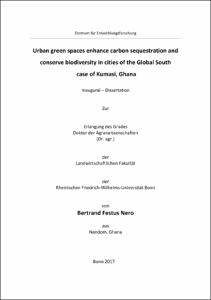Nero, Bertrand Festus: Urban green spaces enhance carbon sequestration and conserve biodiversity in cities of the Global South : case of Kumasi, Ghana. - Bonn, 2017. - Dissertation, Rheinische Friedrich-Wilhelms-Universität Bonn.
Online-Ausgabe in bonndoc: https://nbn-resolving.org/urn:nbn:de:hbz:5n-45974
Online-Ausgabe in bonndoc: https://nbn-resolving.org/urn:nbn:de:hbz:5n-45974
@phdthesis{handle:20.500.11811/7002,
urn: https://nbn-resolving.org/urn:nbn:de:hbz:5n-45974,
author = {{Bertrand Festus Nero}},
title = {Urban green spaces enhance carbon sequestration and conserve biodiversity in cities of the Global South : case of Kumasi, Ghana},
school = {Rheinische Friedrich-Wilhelms-Universität Bonn},
year = 2017,
month = jan,
note = {Urbanization has the propensity to alter ecosystems, enervate ecosystem function and possibly jeopardise human wellbeing. While adequate integration of nature into the city landscape can pragmatically ameliorate urban environmental challenges, particularly those related to climate change and ecosystem degradation, in the developing regions, especially in Africa, urban green spaces (UGS) are hardly planned for and their ecosystem services unquantified and hence misappropriated. This study analyses 1) the spatio-temporal dynamics and distributional equity, 2) carbon sequestration potential, and 3) biodiversity patterns of UGS in Kumasi metropolis, Ghana. Direct ecosystem assessment (inventory and survey) and remote sensing techniques were adopted in this study.
The vegetation cover of Kumasi is about 33 % and is declining fourfold faster in recent years (2009 – 2014) than previously (986 – 2001). Per capita UGS area for 2009 and 2014 are significantly correlated with the socio-economic conditions of submetropolis. The green area stores about 3758.1 Gg C: equivalent to 270±22 t C/ha per UGS cover or 125.7 ± 8 t C/ha for the entire study area in both soil and vegetation. Exactly 176 tree species in 46 families of both native and exotic origins occur in the city. Carbon stocks and species richness differ significantly across UGS types. Natural forest, public parks, cemeteries and institutional compounds stored more carbon in vegetation whereas soil organic carbon storage was highest in the home gardens, farmlands, plantations, and grasslands. The outer fringes of the city support more species and carbon stocks than the core urban area. Species and trait diversity are important drivers of urban ecosystem productivity (carbon storage). UGS species richness correlated strongly with vegetation carbon storage in the city.
UGS are carbon sinks and biodiversity reservoirs which can be relevant to climate change mitigation and adaptation as well as the overall wellbeing of urbanites. However, UGS cover is currently plummeting and is threatened by further urbanization processes including rise in population. Maintenance, expansion, and uniform distribution of green spaces in cities should be a priority for planners, national and local governments as well as traditional leaders. It is recommended that urban biodiversity and carbon stocks be integrated into national and regional biodiversity and carbon stock assessments in Africa.},
url = {https://hdl.handle.net/20.500.11811/7002}
}
urn: https://nbn-resolving.org/urn:nbn:de:hbz:5n-45974,
author = {{Bertrand Festus Nero}},
title = {Urban green spaces enhance carbon sequestration and conserve biodiversity in cities of the Global South : case of Kumasi, Ghana},
school = {Rheinische Friedrich-Wilhelms-Universität Bonn},
year = 2017,
month = jan,
note = {Urbanization has the propensity to alter ecosystems, enervate ecosystem function and possibly jeopardise human wellbeing. While adequate integration of nature into the city landscape can pragmatically ameliorate urban environmental challenges, particularly those related to climate change and ecosystem degradation, in the developing regions, especially in Africa, urban green spaces (UGS) are hardly planned for and their ecosystem services unquantified and hence misappropriated. This study analyses 1) the spatio-temporal dynamics and distributional equity, 2) carbon sequestration potential, and 3) biodiversity patterns of UGS in Kumasi metropolis, Ghana. Direct ecosystem assessment (inventory and survey) and remote sensing techniques were adopted in this study.
The vegetation cover of Kumasi is about 33 % and is declining fourfold faster in recent years (2009 – 2014) than previously (986 – 2001). Per capita UGS area for 2009 and 2014 are significantly correlated with the socio-economic conditions of submetropolis. The green area stores about 3758.1 Gg C: equivalent to 270±22 t C/ha per UGS cover or 125.7 ± 8 t C/ha for the entire study area in both soil and vegetation. Exactly 176 tree species in 46 families of both native and exotic origins occur in the city. Carbon stocks and species richness differ significantly across UGS types. Natural forest, public parks, cemeteries and institutional compounds stored more carbon in vegetation whereas soil organic carbon storage was highest in the home gardens, farmlands, plantations, and grasslands. The outer fringes of the city support more species and carbon stocks than the core urban area. Species and trait diversity are important drivers of urban ecosystem productivity (carbon storage). UGS species richness correlated strongly with vegetation carbon storage in the city.
UGS are carbon sinks and biodiversity reservoirs which can be relevant to climate change mitigation and adaptation as well as the overall wellbeing of urbanites. However, UGS cover is currently plummeting and is threatened by further urbanization processes including rise in population. Maintenance, expansion, and uniform distribution of green spaces in cities should be a priority for planners, national and local governments as well as traditional leaders. It is recommended that urban biodiversity and carbon stocks be integrated into national and regional biodiversity and carbon stock assessments in Africa.},
url = {https://hdl.handle.net/20.500.11811/7002}
}






